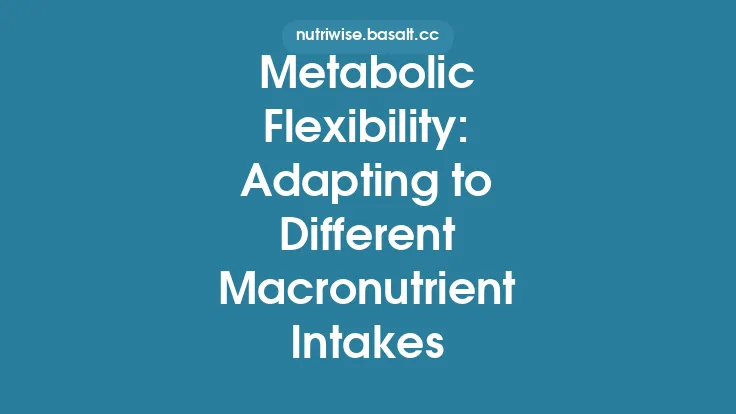Magnesium is often celebrated for its role in muscle contraction and recovery, but its influence extends far beyond those immediate effects. For endurance athletes—runners, cyclists, triathletes, and anyone who relies on sustained aerobic performance—maintaining an optimal magnesium balance can be a decisive factor in how efficiently the body produces energy, regulates fluid shifts, and adapts to training stress. This article explores the physiological pathways through which magnesium supports endurance, outlines practical strategies for monitoring and adjusting magnesium status, and offers evidence‑based recommendations for integrating magnesium management into a comprehensive endurance training plan.
The Metabolic Backbone: Magnesium in ATP Production and Oxidative Phosphorylation
Every molecule of adenosine triphosphate (ATP) that fuels muscular work exists as a magnesium‑bound complex (Mg‑ATP). This binding stabilizes the high‑energy phosphate bonds and is essential for the activity of enzymes that catalyze the steps of glycolysis, the citric acid (Krebs) cycle, and oxidative phosphorylation. In the mitochondria, magnesium acts as a co‑factor for:
- ATP synthase (Complex V) – the enzyme that synthesizes ATP from ADP and inorganic phosphate during the electron transport chain.
- Isocitrate dehydrogenase and α‑ketoglutarate dehydrogenase – key dehydrogenases in the Krebs cycle that generate NADH for the electron transport chain.
- Pyruvate dehydrogenase complex – the gateway that converts pyruvate (the end product of glycolysis) into acetyl‑CoA, feeding the Krebs cycle.
When magnesium availability is suboptimal, the efficiency of these enzymatic reactions declines, leading to reduced ATP turnover. For an endurance athlete, this translates into a lower maximal aerobic power (VO₂max) and an earlier onset of metabolic fatigue, even if muscle contractile function appears intact.
Electrolyte Homeostasis and Fluid Shifts During Prolonged Exercise
Endurance events impose sustained sweating, which can result in the loss of up to 1–2 g of magnesium per hour in hot conditions. Magnesium contributes to the regulation of:
- Sodium–potassium pump (Na⁺/K⁺‑ATPase) – maintaining the electrochemical gradient essential for nerve impulse propagation and muscle excitability.
- Calcium handling – magnesium competes with calcium at voltage‑gated channels, preventing excessive intracellular calcium accumulation that can impair relaxation and increase oxidative stress.
- Cellular osmolarity – as a major intracellular cation, magnesium helps balance intracellular and extracellular fluid volumes, influencing plasma volume expansion and cardiovascular output during long‑duration exercise.
A well‑balanced magnesium status therefore supports optimal plasma volume, reduces the risk of exercise‑associated hyponatremia, and helps preserve neuromuscular coordination throughout the race.
Hormonal Interplay: Magnesium, Stress Hormones, and Energy Mobilization
Endurance training triggers a cascade of hormonal responses, notably the release of catecholamines (epinephrine, norepinephrine) and cortisol. Magnesium modulates these pathways in several ways:
- Catecholamine Synthesis – magnesium is required for the activity of tyrosine hydroxylase, the rate‑limiting enzyme in catecholamine production. Adequate magnesium ensures a balanced sympathetic response, facilitating glycogenolysis and lipolysis without excessive cardiovascular strain.
- Cortisol Regulation – low magnesium levels have been linked to heightened cortisol secretion, which can impair glycogen storage and promote protein catabolism. Maintaining magnesium helps keep cortisol within a range that supports training adaptation rather than chronic catabolism.
- Insulin Sensitivity – magnesium improves insulin receptor signaling, aiding glucose uptake by skeletal muscle during prolonged activity and enhancing glycogen replenishment post‑exercise.
By influencing these hormonal axes, magnesium indirectly contributes to the athlete’s ability to mobilize and utilize energy substrates efficiently over long periods.
Assessing Magnesium Status: From Clinical Tests to Practical Field Indicators
Because only about 1 % of total body magnesium resides in the extracellular fluid, serum magnesium alone can be a misleading indicator of true magnesium status. A comprehensive assessment for endurance athletes should combine:
| Assessment Tool | What It Measures | Practical Considerations |
|---|---|---|
| Serum Magnesium | Free (ionized) magnesium in blood | Quick, inexpensive, but may miss intracellular deficits |
| Red Blood Cell (RBC) Magnesium | Intracellular magnesium within erythrocytes | More reflective of tissue stores; requires specialized lab |
| 24‑Hour Urinary Magnesium Excretion | Amount of magnesium eliminated in urine | Useful for evaluating absorption and renal losses, especially after heavy sweating |
| Magnesium Loading Test (IV or oral) | Change in serum magnesium after a known dose | Gold standard for functional deficiency; not routinely used in sport settings |
| Performance‑Based Markers (e.g., early rise in heart rate, perceived exertion) | Indirect signs of electrolyte imbalance | Helpful for day‑to‑day monitoring; must be interpreted alongside other data |
Athletes should aim for a baseline assessment during a rested state, followed by periodic re‑evaluation after training blocks, altitude exposure, or heat acclimatization phases.
Nutrition Strategies for Sustained Magnesium Balance
While the article’s scope excludes a catalog of magnesium‑rich foods, it is still valuable to discuss the broader dietary patterns that support steady magnesium intake without over‑reliance on single food sources.
- Whole‑Grain Emphasis – Whole grains (e.g., oats, quinoa, brown rice) provide a matrix of magnesium, fiber, and B‑vitamins that collectively support energy metabolism.
- Balanced Plant‑Based Proteins – Legumes, nuts, and seeds contribute magnesium alongside amino acids that aid in muscle repair and glycogen synthesis.
- Timing of Carbohydrate‑Rich Meals – Consuming carbohydrate‑dense meals with moderate magnesium content within the post‑exercise window (30–60 min) can enhance glycogen replenishment while simultaneously delivering magnesium for mitochondrial recovery.
- Hydration Solutions – Sports drinks formulated with a modest magnesium concentration (≈10–15 mg/L) can offset sweat losses during ultra‑endurance events without causing gastrointestinal distress.
- Avoiding Antagonists – High intakes of phytates (found in unprocessed grains) and excessive calcium supplements can impair magnesium absorption. Pairing magnesium‑containing foods with vitamin D and modest amounts of healthy fats improves bioavailability.
Supplementation Protocols Tailored to Endurance Demands
When dietary intake alone cannot meet the elevated magnesium requirements of high‑volume training, supplementation becomes a practical tool. The following guidelines are based on current consensus from sports nutrition societies:
- Form Selection – Chelated forms (e.g., magnesium glycinate, magnesium citrate) exhibit higher intestinal absorption rates (≈30‑40 % higher) compared to inorganic salts (magnesium oxide).
- Dosage – For most endurance athletes, a daily supplemental dose of 200–400 mg elemental magnesium is sufficient to offset sweat losses and support metabolic functions. Doses above 500 mg may increase the risk of loose stools, especially when taken in a single bolus.
- Timing – Splitting the dose into two administrations (morning and early evening) promotes steady plasma levels and reduces gastrointestinal side effects. For ultra‑endurance events lasting >4 h, a small intra‑event dose (≈50 mg) incorporated into a carbohydrate‑electrolyte gel can help maintain magnesium balance.
- Interaction with Other Supplements – Co‑administration with vitamin B6 (pyridoxine) has been shown to enhance magnesium utilization in energy pathways. However, high doses of zinc (>30 mg) can compete for absorption; spacing zinc and magnesium intake by at least 2 h mitigates this effect.
- Monitoring – Athletes should track subjective markers (e.g., perceived exertion, muscle “tightness”) alongside objective measures (urinary magnesium) during the first 2–3 weeks of supplementation to fine‑tune the regimen.
Periodization of Magnesium Management Across Training Cycles
Endurance training is rarely linear; it comprises phases of base building, intensity work, tapering, and competition. Magnesium needs fluctuate accordingly:
| Training Phase | Typical Magnesium Demand | Management Focus |
|---|---|---|
| Base (high volume, low intensity) | Elevated due to prolonged sweating and high mitochondrial turnover | Emphasize daily dietary magnesium, consider modest supplementation (200 mg) |
| Build (moderate volume, increased intensity) | Increased need for ATP regeneration and stress hormone modulation | Add a second daily dose, monitor cortisol and heart‑rate variability |
| Peak/Taper (reduced volume, high intensity) | Potential for acute spikes in catecholamine output and glycogen depletion | Optimize timing of magnesium‑rich meals post‑high‑intensity sessions, ensure adequate rehydration |
| Competition (race day) | Acute losses through sweat and rapid energy turnover | Use intra‑event magnesium‑electrolyte gels, pre‑race magnesium‑citrate drink (≈100 mg) to top‑up stores |
By aligning magnesium intake with the physiological stressors of each phase, athletes can avoid the “energy cliff” that often occurs when metabolic efficiency wanes despite preserved muscle contractility.
Practical Tools for the Endurance Athlete
- Magnesium Tracking Apps – Several nutrition platforms now allow users to log magnesium intake and receive alerts when daily targets fall below 80 % of the recommended amount.
- Sweat Rate Testing – Conduct a controlled sweat test (e.g., 30‑minute treadmill run in a climate chamber) to quantify magnesium loss per liter of sweat; use the data to personalize intra‑event electrolyte solutions.
- Portable Urine Test Strips – Emerging point‑of‑care strips can estimate urinary magnesium concentration, offering a quick feedback loop for daily adjustments.
- Recovery Journals – Document sleep quality, perceived fatigue, and heart‑rate variability alongside magnesium intake; patterns often emerge that guide long‑term strategy.
Summary of Key Takeaways
- Metabolic Role – Magnesium is indispensable for ATP synthesis, mitochondrial enzyme activity, and efficient aerobic energy production.
- Electrolyte Balance – It stabilizes fluid shifts, supports Na⁺/K⁺‑ATPase function, and moderates calcium dynamics, all of which are critical during prolonged sweating.
- Hormonal Modulation – By influencing catecholamine synthesis, cortisol regulation, and insulin sensitivity, magnesium helps the body mobilize and utilize fuel stores without excessive catabolic stress.
- Assessment – A combination of serum, RBC, urinary, and performance markers provides the most accurate picture of magnesium status for endurance athletes.
- Nutrition & Supplementation – Whole‑grain, plant‑based dietary patterns, strategic timing of magnesium‑containing meals, and well‑chosen chelated supplements (200–400 mg/day) sustain optimal levels.
- Periodized Management – Align magnesium intake with training phases, using higher doses during high‑volume periods and targeted intra‑event dosing for races.
- Practical Implementation – Leverage technology (apps, sweat testing, urine strips) and systematic tracking to fine‑tune magnesium strategies over the long term.
By integrating these evidence‑based practices, endurance athletes can harness magnesium’s full potential—not merely as a muscle‑support nutrient, but as a central regulator of energy metabolism, fluid balance, and hormonal harmony—thereby extending their performance envelope and achieving more consistent, resilient endurance outcomes.





